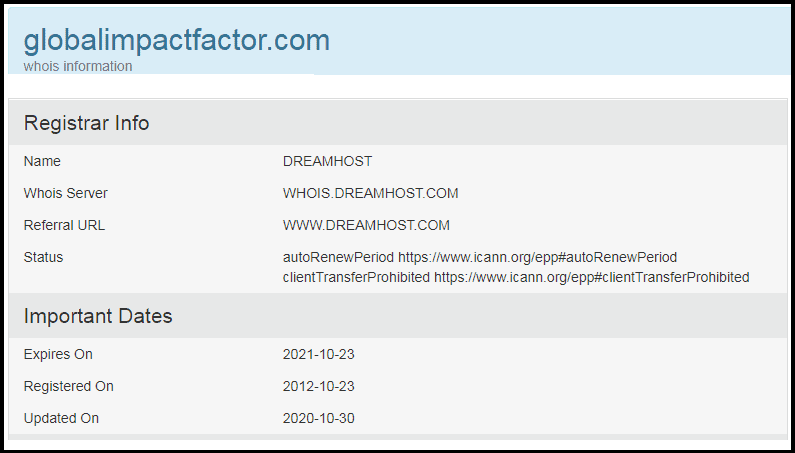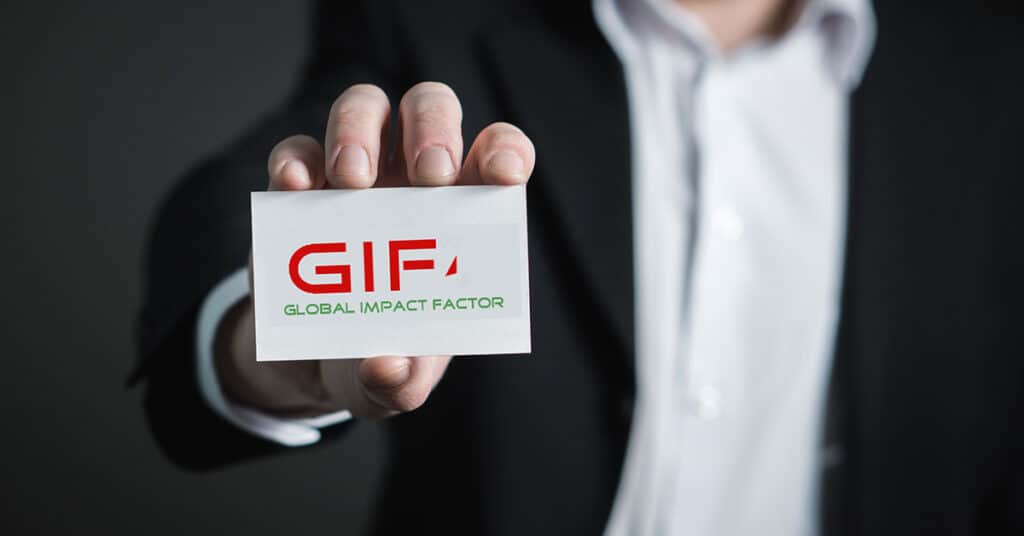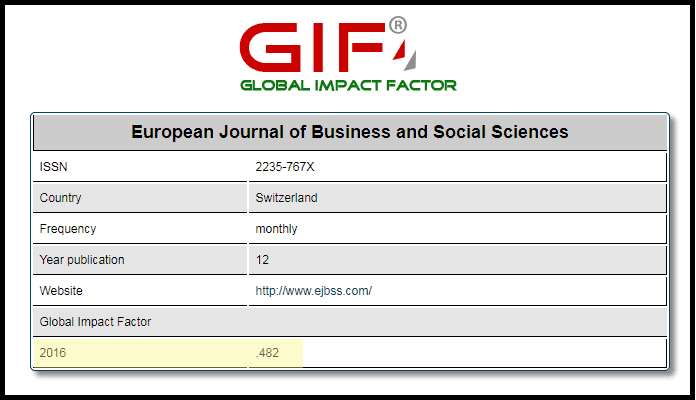When somebody refers to an impact factor it is usually taken to mean that it is a measure of how many times articles in a given journal are cited in other journals, or even self-cited. In this article we look at one of these measures, the Global Impact Factor.
In recent years, there has been a proliferation of fake impact factors, which predatory publishers/journals use to try and give their journals a feeling of legitimacy. In the same way that predatory journals try to attract papers from authors, fake impact factors try to attract predatory journals so that the journals can give an illusion of legitimacy.
The Global Impact Factor (GIF) is was introduced a few years ago. This is the impact factor that we focus on in this article, attempting to arrive at a view as to whether it is a fake impact factor, or not?
What is the Global Impact Factor (GIF)? GIF ranks journals using quantitative and qualitative methodologies in order to evaluate the prestige of journals. The evaluation considers factors such as peer review, originality, quality, technical editing quality, editorial quality and regularity.
What is an Impact Factor?
An impact factor is, in most people’s understanding, a way of measuring how many times articles for a given journal, in a given time frame, have been cited. An impact factor could be calculated as follows:
x = the number of times articles published in a given time period (say 2015-2019) were cited by other (possibly only indexed) journals in a given time period.
y = the total number of papers published in the given time period.
x/y = the Impact Factor for the journal
As an example, if a journal had published 63 (citable) papers between 2015-2019 and they had been cited 171 times in 2020, the journal would have a 2020 impact factor of (171/63) = 2.71. This means that, on average, each paper in that five year period had been cited 2.71 times.
It should be noted that an impact factor, as defined above, is a measure that can only be applied to a journal, not to individual articles.
We note that there are a number of different ways to arrive at a given impact factor but they are usually based on the number of citations that the articles in the journal has attracted.
What is the URL for Global Impact Factor?
When we first tried to access the the Global Impact Factor web site, on the 29 Oct 2020, it was not available. The site returned a few days later, but we record what we saw in Appendix A, just so that we have a record and it may also be useful for others to see how you can look up details of a web site.
If you search for “Global Impact Factor” you will see the web site:
http://globalimpactfactor.com/
Accessing the web site, you will see a page that looks like that shown in Figure 1.
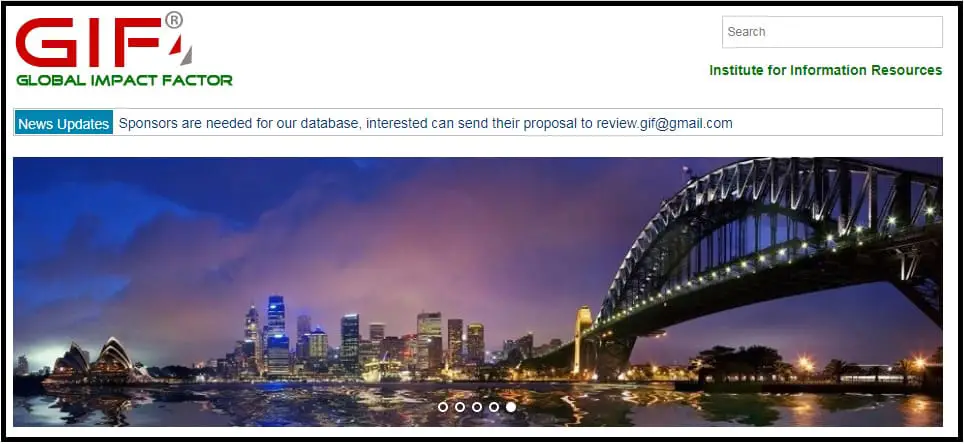
Searching for Global Impact Factor
If you search for “Global Impact Factor“, you would expect to see limited results but there are actually an assortment of results, in addition to the GIF web site.
One of them, rather strangely in our view, is a link to a journal called the International Journal of Core Engineering & Management.
The search result goes to a page, where the GIF impact factor is stated. We show this in Figure 2.
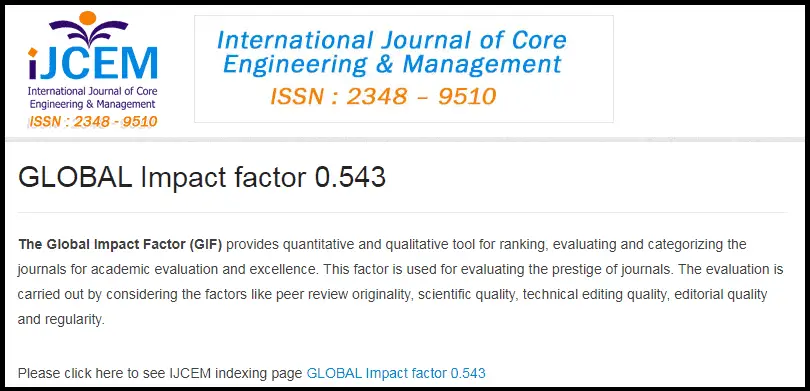
If you look around this journal’s web site, you can find a page which lists all of its impact factors (see Figure 3).
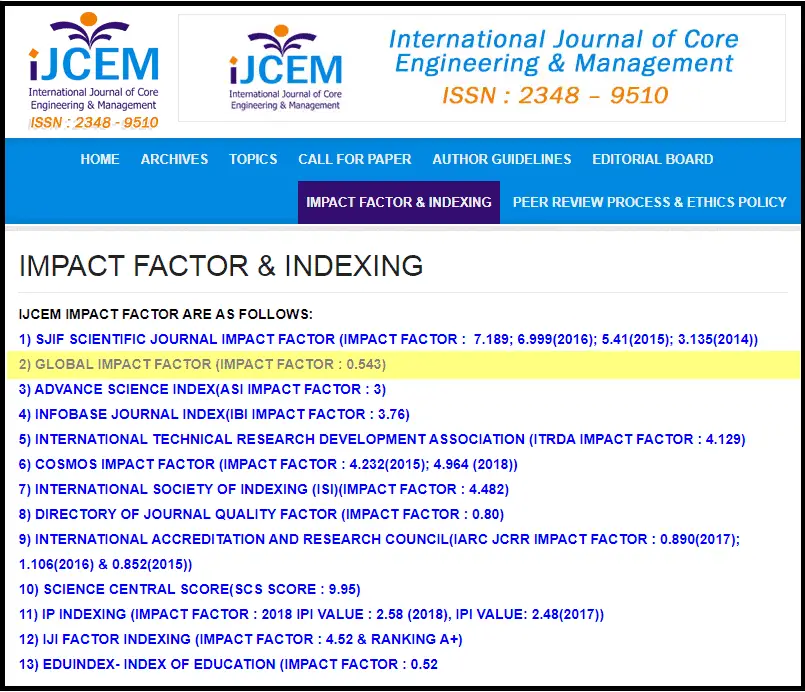
To be honest, we do not understand why a specific journal (when GIF indexes over 3,000 journals) appears so high up the search list when you search for GIF. Anyhow, we thought it was worthy of mention.
Who is Behind Global Impact Factor?
Normally, you would look at the web site to see if there is an “About Us” (or similar) section to look at, but the GIF web site has no such sections. Therefore, it is not apparent from the web site who is behind GIF, how they can be contacted, the individuals involved and whether GIF is supported by any stakeholders, such as publishers.
A wider search, enables us to see the following.
Jalalian 2015 paper
If you look at the following paper:
- Jalalian M. (2015) The story of fake impact factor companies and how we detected them. Electronic Physician, 7(2):1069-1072. DOI: https://dx.doi.org/10.14661/2015.1069-1072.
… it specifically talks about the Global Impact Factor. On the issue of who is behind it, it says:
“The Global Impact Factor (GIF) was among the first fake metrics, and it first appeared on the scene October 24, 2012 by the invisible cybercriminal whom I identified to be Mr. [redacted], using the phone number [redacted] and address [redacted] in the South Asian country [redacted].“
The redactions, are in the paper itself, rather than us making those redactions for this article. It is a shame, but understandable, that the author of that paper decided to redact the name of the person they had identified.
Stef Brezgov blog
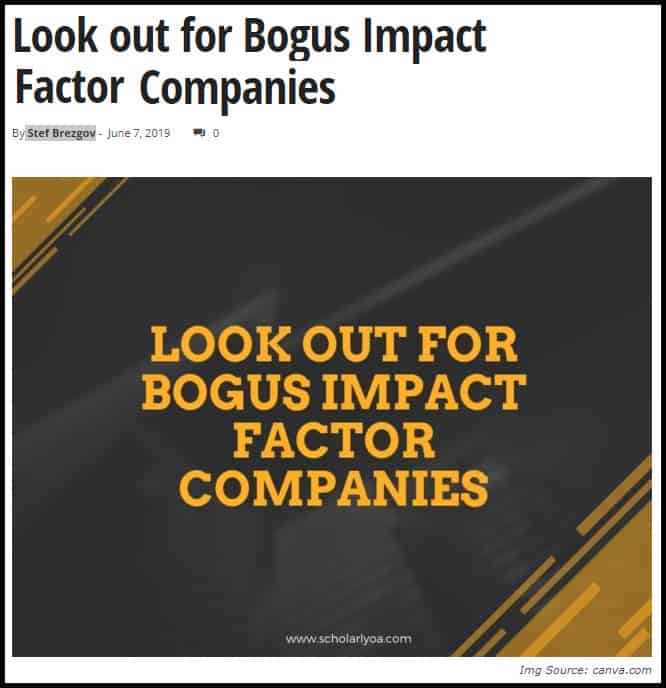
We found a blog post from Stef Brezgov, that was published in June 2019. This post has a section on Global Impact Factors and with regard to their location, it says:
“This company provides an address in Australia, but I think it is really from India.“
This does not help us find out who is behind GIF, but it does correspond with the Jalalian, 2015 paper, which mentions a South Asian country.
So …..
We have been trying to trace the name of the person that set up GIF, but have not been able to find anything. We suspect it was in the public domain, but it is now difficult to find out that name now.
If you have more information about who is behind GIF, we would be grateful if you could let us know. We could then use that information as the starting points for further searches.
How does Global Impact Factor Calculate Impact Factors?
The GIF webs site has a specific section on how it calculates its impact factor. There are also others resources we have found that makes comment on this.
GIF Web site
The GIF web site has a specific page that describes how its impact factors are calculated.
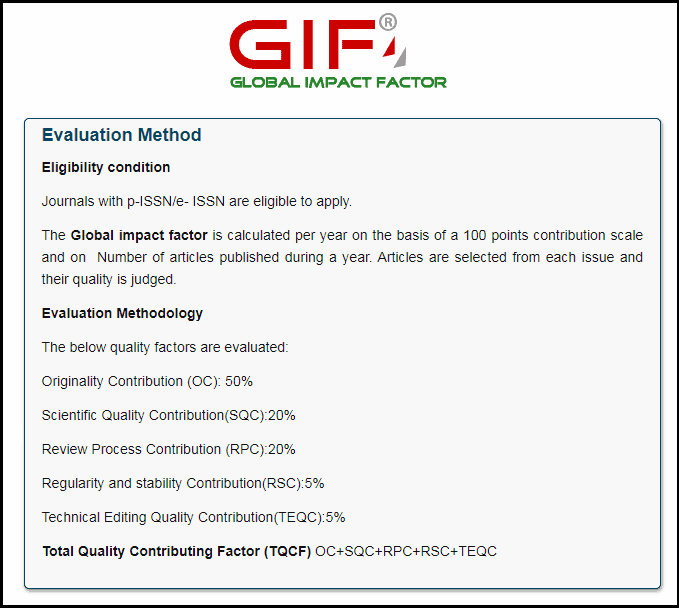
Figure 5 (from the GIF web site) shows the way that the impact factor is calculated, with more details being available on the web site.
We make the following observations about the methodology adopted by the Global Impact Factor:
- When GIF calculates its impact factors, none of the criteria takes into account the number of times an article is cited, which is what most people would think, when the term impact factor is used.
- As far as we can ascertain, the GIF impact factor is subjective. That is, they cannot be verified by an independent observer. For example, if a journal is given an impact factor of 0.581, how is this derived and what contribution do the individual criteria provide to this overall value?
- It states (see Figure 3) that the impact factor is calculated “per year“. If we look at individual journals we can see that many of the impact factors are dated 2019, but there are some that have others dates. For example, the “European Journal of Business and Social Sciences” (see Figure 6).
- Assuming that the impact factors are (re-)calculated each year, it would be useful to see the previous year’s impact factors as this would provide information to the readers as to whether the journal is improving, or not.
- There is a list of reviewers, which appear to be the scholars who make the judgments on each journal.
- In the methodology (Figure 5), it says that “Articles are selected from each issue and their quality is judged.” It would be useful to know how the articles are selected, and who makes those selections.
Stef Brezgov blog
In the same blog post that we referred to above (see Figure 4) it provides a view on how GIF calculates its impact factor.
“It uses experts to make qualitative judgments about each journal, and that’s how the score is calculated.“
and
“It judges journals on things such as layout and technical editing, so it’s really not a measure of impact at all.“
Researchgate question
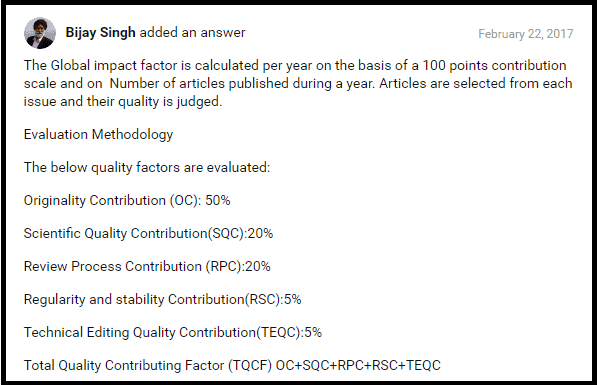
In February 2017, somebody posed a question about who was running Global Impact Factor. Figure 7 shows one of the answers in this thread, outlining how GIF calculates its impact factors.
This resonates with the views given by Stef Brezgov who said that it looks things like layout and technical editing are used, which is supported by the GIF web site (see Figure 5).
What Journals does Global Impact Factor Cover?
THE GIF web site lists all of the journals that it indexes. In total, (as of 5 Nov 2020), 3,337 journals are listed. Figure 8 shows part of the first page.
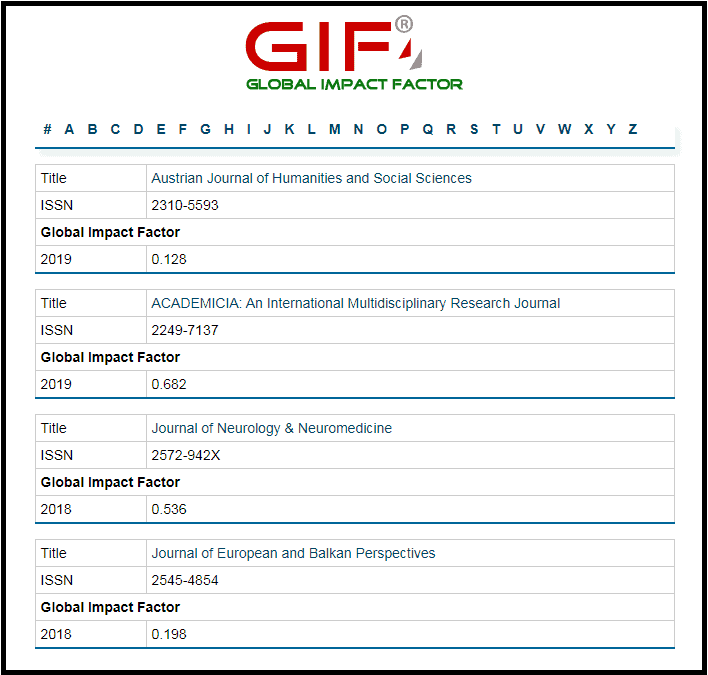
Data Collection
We decided to invest some time and look at all the journals that were indexed by Global Impact Factor. This was a significant undertaking, given that were almost 3,500 journals.
We thought it was worth collecting this data from the Global Impact Factor web site, for a number of reasons:
- It marks a specific point in time. Web sites are constantly changing and being able to reference a known time, with known content, could be useful for a number of reasons.
- It provides a benchmark for future studies. Having this data gives us a point of reference that we can compare against at a later date.
- We may be able to use this data for other ideas we have in mind, with the most obvious one being a peer reviewed scientific paper. We are not sure what form this will take at the moment, but having the data is a good starting point.
From the Global Impact Factor web site we collected the following data:
- The URL where the details of the journal are displayed on the GIF web site.
- The journal ISSN
- The title of the journal
- The URL of the journal
- The GIF impact factor
- Although it is not provided as part of the GIF web site we also recorded whether the journal is part of COPE and DOAJ. This is discussed in more detail in the next section.
The list of journals is too large to display on this page, so we have provided a list of the journals that are indexed by Global Impact Factor in this PDF file, in case you are interested. It is the same information that you could get from the web site. All we have done is consolidate it into a single document.
COPE and DOAJ
- COPE Committee on Publication Ethics): This organisation promotes (to quote from their web site)
“COPE is committed to educating and supporting editors, publishers and those involved in publication ethics with the aim of moving the culture of publishing towards one where ethical practices becomes a normal part of the publishing culture. Our approach is firmly in the direction of influencing through education, resources and support of our members, alongside the fostering of professional debate in the wider community.“
Journals that are members of COPE are required to adhere to their ethical guidelines. If a journal is a member of COPE it is a good indicator that they are a legitimate journal. If a journal is not a member of COPE it does not mean that the journal is predatory, but you may want to carry our further checks.
- DOAJ (Directory of Open Access Journals): This web site maintain a list of open access journals, which they recognise after carrying out a number of checks. This is done in order to try and maintain a list of legitimate open access journals.
If a journal is listed on the DOAJ web site, it is an indicator that the journal is legitimate. The fact that it is not listed on DOAJ does not automatically mean that the journal is predatory, but it is a an indication that you may want to carry out further checks.
If you want to know more about DOAJ, we have written an article on this topic. If you are interested, see “What is the Directory of Open Access Journals (DOAJ)?“
One word of caution, if a journal says that it is a member of COPE and/or DOAJ, you are advised to verify this by looking at the COPE/DOAJ web sites, as some journals have been known to use their logos, without actually being members.
Some predatory journals will also say that they adhere to COPE guidelines, without actually being members. They are not being untruthful (although they might not actually adhere to the COPE guidelines), but the unsuspecting author may believe that they are a member of COPE.
For a previous project that we were involved in, we wrote some software that ascertains whether a journal is a member of COPE and/or DOAJ. It is a relatively quick process to work through the 3,337 journals and identify their membership status. We feel that this significantly adds to the quality of the dataset.
Comments
After collecting all the data from the GIF web site, and then enhancing it with the COPE/DAOJ membership information we can make the following comments about the 3,337 journals currently indexed by the Global Impact Factor. This data collection was carried out on 5 Nov 2020.
- The GIF web site lists 3,337 journals.
- 80 (2.40%) of those journals are members of COPE. 3,257 (97.60%) are not.
- 422 (12.65%) of the journals are members of DOAJ. 2,915 (87.35%) are not.
- 40 (1.20%) journals are members of both COPE and DOAJ.
- 106 (3.18%) of the journals are marked as “Pending Evaluation“. That is, they have not yet been given a Global Impact Factor.
- A further 95 (2.85%) journals do not have an impact factor listed. That is, this data is just blank.
- So, a total of (106+95) = 201 (6.02%) journals do not have an Global Impact Factor listed.
- 49 (1.47%) of the journals did not have an ISSN listed.
- 203 (6.08%) journals had the same ISSN as another journal. To be precise 100 journals had two entries for the same ISSN and one ISSN was repeated three times.
With regard to the duplicate ISSN’s, we show two examples in Figures 9 and 10. Figure 9 shows two entries for the same journal (Journal of Physical Education Research), one appearing on page 18 of the search pages and one appearing on page 75. The only difference is the online ISSN that appears in the second entry. Notably the impact factors have the same value (0.765).

Figure 10 shows another journal (Mathematical and Software Engineering). One entry appears on page 2, the other entry appears on page 51. On this occasion, the impact factors are different (0.663 and 0.454).

It is worrying that the same journal can appear twice, but data errors do occur. What is more worrying is that the same journal can appear twice and have different impact factors.
Do all the Journals exist that are indexed by Global Impact Factor?
As we carried out our investigation, we did see some URL’s that led to “page not found“. An an example, the journal Journal of Social and Business Studies, is shown on the GIF web site (see Figure 11), showing that it was established in 2004 and it has an impact factor of 0.169.
If you follow the link to the journal itself, that is http://www.sbdcenter.com/jsbs/, it leads to a page that does not exist.

You may think that this is conclusive evidence that the journal does not exist and, perhaps, has never done so.
However, if you look up the journal on the ISSN web site (see Figure 12), you see that a journal of that name, with an ISSN 2303-6044 does (or at least did) exist.
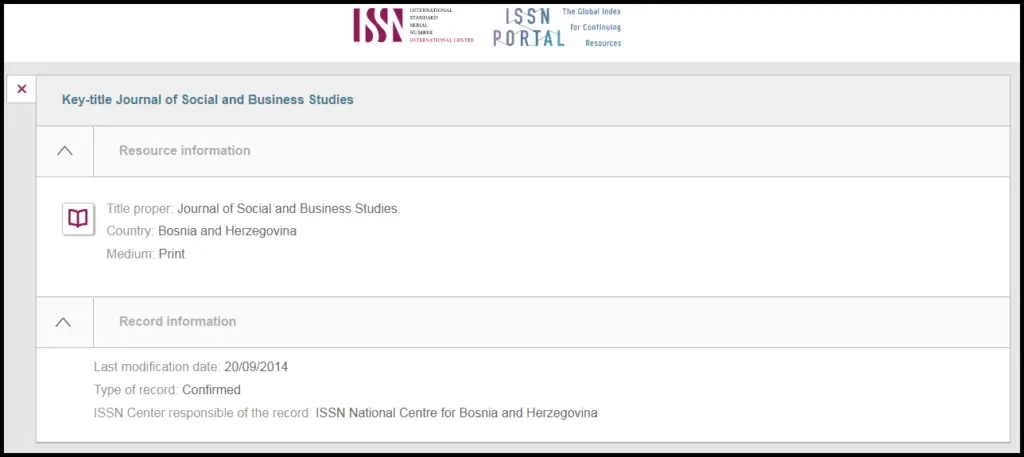
The journal entry was last updated on 20 Sep 2014 on the ISSN web site, but at least it shows that it was a journal that has an ISSN number.
If you want to know more about ISSN numbers, please take a look at our article “What is an ISSN (International Standard Serial Number)?“
So, it is not as easy as saying that as the URL on the GIF web site does not work, the journal does not exist. Much more investigation is required to ascertain the true status of the journal.
Are Journals Aware that they are Listed on Global Impact Factor?
This is a difficult question to answer, as it potentially means that we have to contact all the journals or, at a minimum, we need to look at every web site. This is not really practical as it would take a lot of time, not least of as the information about whether a journal is a member of GIF would not be in a same location on every web site.
But we can do a few random checks. We took the top five ranked articles and looked at their web sites to see if they mentioned “GIF” or “Global Impact Factor“. We searched the web sites by inspection and also by searching the web site, limiting the search to just the domain of the journal. For example, if you want to search for “Beall“, but limit that search to the predatory-publishing.com domain, you would use the (Google) search term:
site:predatory-publishing.com Beall
The five top ranked journals are shown in table 1.
| ISSN | Title | GIF |
| 2281-7352 | International Journal on Heat and Mass Transfer | 675 |
| 2223-0343 | Research Opinions in Animal & Veterinary Sciences | 675 |
| 2455-930X | International Research Journal of Multidisciplinary Science &Technology | 415 |
| 0021-9738 | Journal of Clinical Investigation | 20.654 |
| 2277-4106 | International Journal of Current Engineering and Technology (IJCET) | 7.151 |
Looking at Table 1, we suspect that the top three journals should really have impact factors of 0.675, 0.675 and 0. 425, as they seem very high when compared to the other 1,300+ journals. But, if these are errors in their database, it makes no difference to this analysis as it would be equally valid just to choose five journals at random.
Table 2 shows what we found.
| ISSN | Title | By Inspection | By Search |
| 2281-7352 | International Journal on Heat and Mass Transfer | No | No |
| 2223-0343 | Research Opinions in Animal & Veterinary Sciences | No | No |
| 2455-930X | International Research Journal of Multidisciplinary Science &Technology | Yes | N/A |
| 0021-9738 | Journal of Clinical Investigation | No | No |
| 2277-4106 | International Journal of Current Engineering and Technology (IJCET) | Yes | N/A |
Two of the five journals we looked at, had no evidence, that we could find, that they recognized that they were indexed by Global Impact Factor.
As an example, Figure 13 shows one for the web pages from Research Opinions in Animal & Veterinary Sciences. This shows where it is indexed and GIF is conspicuous by its absence.
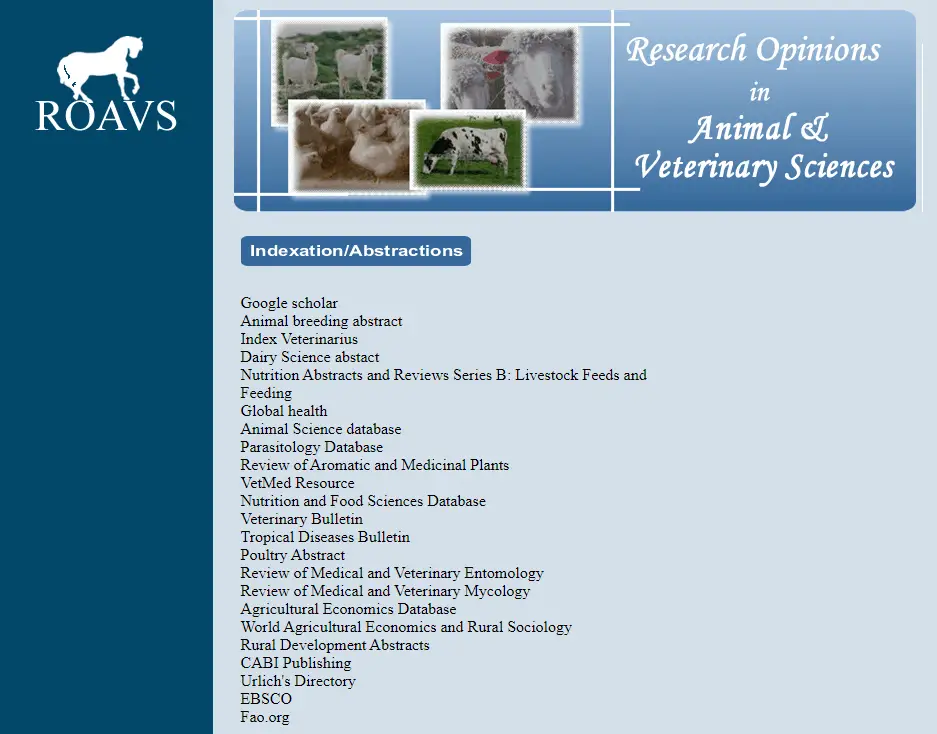
Figure 14 shows the web page for International Research Journal of Multidisciplinary Science &Technology. This shows that it does recognize that it is indexed by GIF and if you click on the area we have circled in red, this will take you to the GIF web site. It is interesting to note that Figure 14 shows the impact factor as 0.415, which resonates with our view that there are some errors in the database, as GIF lists the impact factor as 415.
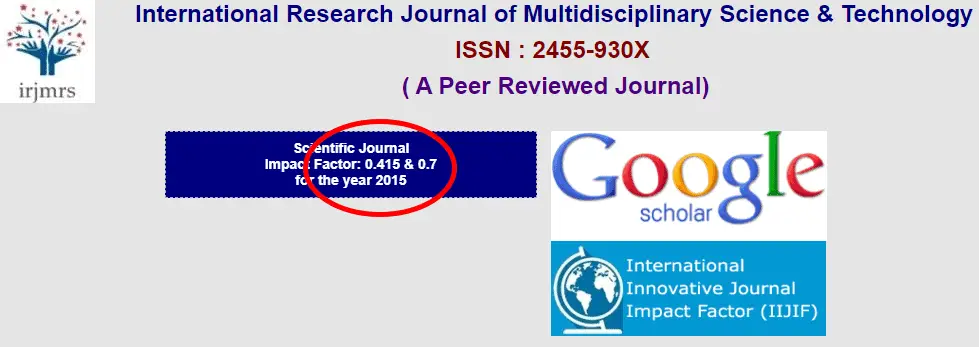
Only looking at five journals is, of course, not a representative sample, but it does show that some journals do not recognize their association with GIF. They may have just missed this data from their web site but you would assume that if they have bothered registering, they would want to promote this association?
Conclusion
The Global Impact Factor, despite being called an impact factor, does not follow what we would usually expect from this term (i.e. a measure of citations). However, there is no reason why an organisation cannot define an impact factor in whatever way they want, as there is no recognized definition, but when there is a defacto definition, it is slightly strange to go against that trend.
It would be nice to simply say that Global Impact Factor is a fake impact measure, or it is not but it is not quite as easy as that. In some respects, you have to make your own decisions based on the information we have presented, along with carrying out your own investigation.
You might reach the conclusion that it is a fake impact measure and you will not submit to any journals that is lists. But you may be doing the journals an injustice. They may not be aware that GIF is fake and entered into the arrangement with them in all good faith. There is also the possibility that some journals are not even members, but GIF still lists them.
The best advice we can give is to say that if journal is listed on the Global Impact Factor you should proceed with caution. Carry out your own due diligence. You might want to make a start by doing the following:
- Check if the journal is a member of COPE and/or DOAJ. Don’t just look at the journal web site. Make sure you check via the COPE/DOAJ web site. As we have said earlier, not being a member of COPE/DOAJ is not conclusive proof that an open acces journal is predatory, but it would suggest that further investigation is worthwhile.
- Check is the journal has ever appeared on Beall’s List. This is quite an old resource now, but it might provide further information for you to make an informed choice.
- Take a look at our article Three Quick Ways to Spot a Predatory Journal. This will enable you to make a few quick checks that may suggest that the journal is predatory.
- We have written another article that says how we would go about Analysing a Journal. You may want to take a look at that.
By far the best advice we can give though is that if you have ANY doubts about a journal, just move on and find another one. The world is not short of suitable journals for you to submit to.
As far as Global Impact Factor is concerned, we have significant concerns about this impact factor. It is not transparent, it does not include citations and the integrity and correctness of its database is open to question.
We would treat Global Impact Factor with extreme caution and not assume that a journal that it indexes is credible. Further due diligence is required.
Appendix A: Accessing the Global Impact Factor website
When we initially tried to follow to access Global Impact Factor (29 Oct 2020) and then, a few days later, it was available again.
Why was the Global Impact Factor web site not available?
When we initially tried to access GIF, it was not available. Figure 8 shows the message we received. We tried several browsers, on different devices and received (essentially) the same message.
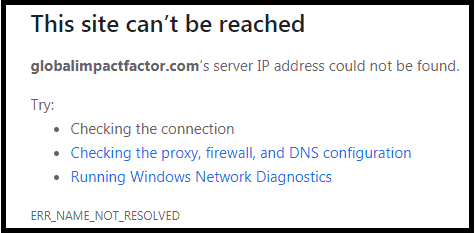
We used who.is to try and establish who owned the web site, as well as looking at some of the other data. You can try it yourself, but this link will provide direct access to the query we made. We note that other services are available, such as whois.net.
Figure 9 shows some of the information that was returned.
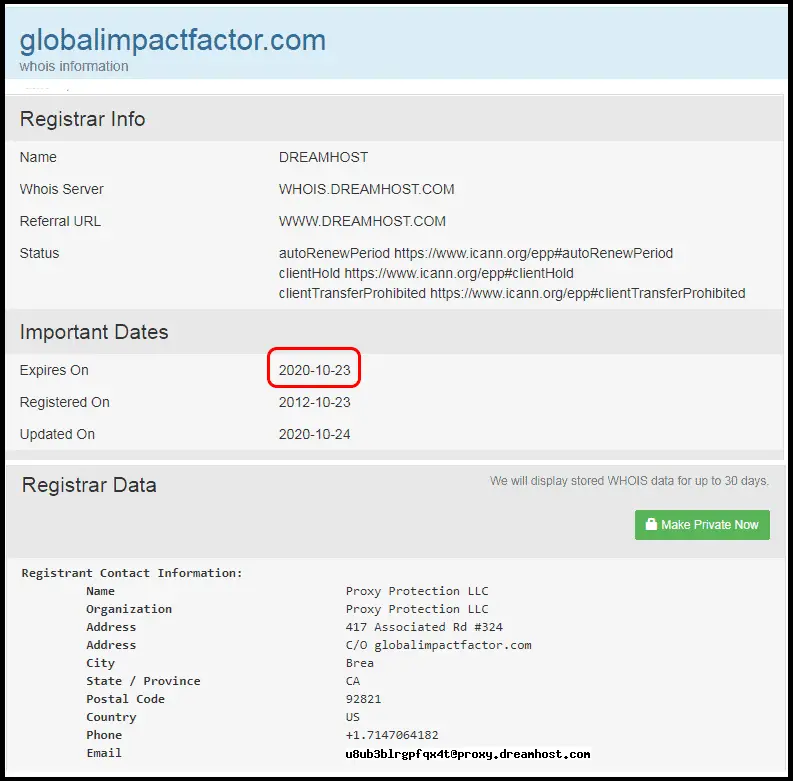
Looking at Figure 9, there are two interesting points.
- It looks as if the domain has recently expired (on 23 Oct 2020), which is presumably the reason why we were unable to access the web site (see Figure 1).
- The Contact information (towards the bottom of Figure 2) shows that the contact information is hidden behind a privacy screen. To be honest, we are not particularly worried about this. Many web sites do this (ourselves included). It is partly protecting your privacy (else you might have your home address displayed) but also to stop others sending scam email after collecting your email address from the who.is web site.
Access to Global Impact Factor was restored
As we neared the completion of this article, the Global Impact Factor web site suddenly started working again. Look at who.is again (see Figure 10), we can see that the domain now expires on 23 Oct 2021, suggesting that it has been renewed in the past few days, sometimes between 29 Oct 2020 and 01 Nov 2020.
